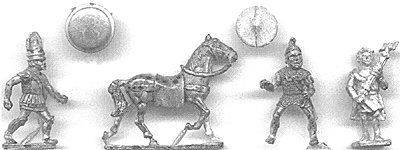 Mirliton of Italy makes a range of Italians which are quite suitable for Hannibal's forces. They are also 28mm, but not as stocky.
Mirliton of Italy makes a range of Italians which are quite suitable for Hannibal's forces. They are also 28mm, but not as stocky.
The Etruscans:
This is a very nice Etruscan Hoplite taken from the fresco at Volterra. He has a transverse crest but could easily have it for and aft by clipping the edges and twisting. He has greaves and wears a linen corslet. He has straight type Greek sword on his left side. Figure comes with a 8' thrusting spear which was omitted due to space and a hoplon.
Horse: The Etruscan horse was taken from the 3rd century funeral urn at Closium. Nice thing about being an company in Italy one can look at the original sources from other angles not in the photograph.
The cavalryman is also taken from Closium. He wears a mail shirt, sandals carries a long narrow sword on his left side. He comes with the Celtic shield and a 6' thrusting spear.
Lictor: This Lictor is unusual as he has a short cape. The rods and axes are very distinct.
 The Oscans:
The Oscans:
These are suitable for Samnites, Campanians, Lucanians and Apulians.
The first cavalryman with the huge crest on the Attic style helmet is taken from Praestum. He has what Livius refers to as "heart protector," a small circular breastplate secured by straps. He has a Greek style sword. The javelin was omitted due to space. He comes with a small aspis, but could have a Celtic ribbed shield as well or no shield.
The classic Campanian cavalry horse taken from a fresco in Capua. It has a chamfron, (face plate) holding upright feathers, and the breast is protected by a poitrail. Both are nicely engraved and I can't wait to start painting these.
Campanian cavalry man: He has the clamshell breastplate, short cloak, Greek sword and comes with a 6' foot thrusting spear. Oscan horse rarely carried shields unless near Tarrentum.
Oscan first class warrior: Oscans were peltast type troops. They could fight hand to hand, but they preferred to skirmish preferably in rough terrain. This warrior has a clamshell breastplate, with a Thracian helmet with side feathers, sign of a Oscan warrior. He can fight hand to hand since he carries a Greek sword. His shield is a cut down Celtic shorn top and bottom to allow for better handling. Samnites may have tapered their bottom part of the shield, based on descriptions of later gladiators, but this is just conjecture. Samnites used pila. Figure could also be used as a Campanian Hoplite since he wears two greaves. All that is needed is a hoplon and thrusting spear.
Oscan second class warrior: Not all Oscans could afford body armor or fancy shields. Often they had to make do with a wicker shield as this javelin man has. Even though he cannot afford body armor, he has a pair of greaves, likely looted. He wears the Oscan wide belt symbol of Oscan manhood, and has a narrow Greek sword. He comes with a javelin and the round whicker shield shown With a change of shield and removing the greaves and feathers, he could be a Roman Leves who later evolved into the Velite. Both figures inspired by frescos in Paestum.
Mirliton are $1.50 each which includes the weapon and shield. They can be bought at GKG Gaming (203) 431-8726. Mirliton itself has a website at www.mirliton.it
Back to Strategikon Vol. 2 No. 1 Table of Contents
Back to Strategikon List of Issues
Back to MagWeb Master Magazine List
© Copyright 2002 by NMPI
This article appears in MagWeb (Magazine Web) on the Internet World Wide Web. Other military history articles and gaming articles are available at http://www.magweb.com